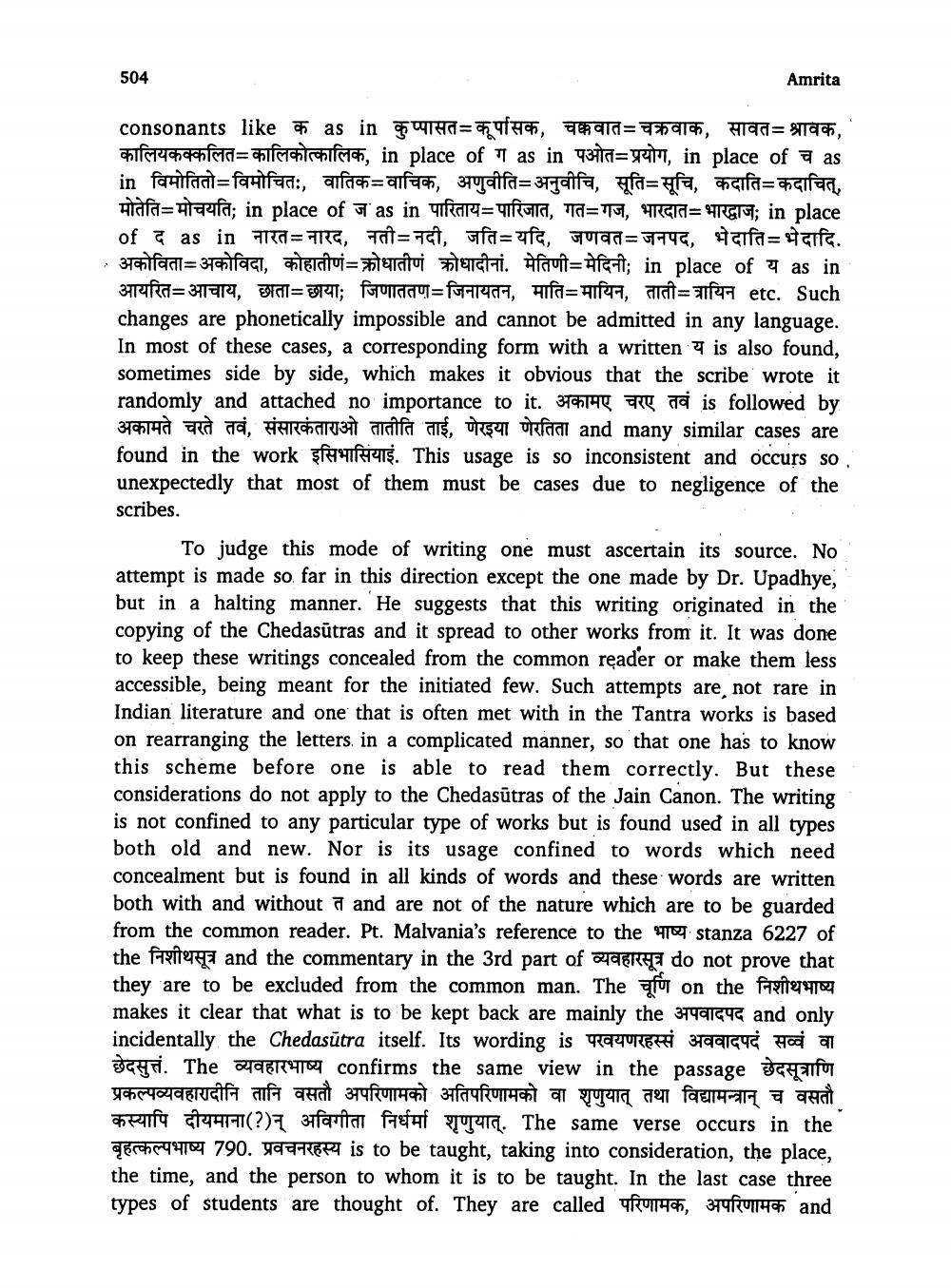________________
504
Amrita
consonants like क as in कुप्पासत= कूसिक, चक्कवात= चक्रवाक, सावत= श्रावक, कालियकक्कलित कालिकोत्कालिक, in place of ग as in पओतप्रयोग, in place of च as in विमोतितो विमोचितः, वातिकवाचिक, अणुवीति= अनुवीचि, सूति सूचि, कदाति=कदाचित्, मोतेति= मोचयति; in place of ज' as in पारिताय= पारिजात, गत=गज, भारदात=भारद्धाज; in place
of द as in नारत= नारद, नती= नदी, जति= यदि, जणवत= जनपद. भेदाति= भेदादि. , अकोविता=अकोविदा. कोहातीणं क्रोधातीणं क्रोधादीनां. मेतिणी=मेदिनी; in place of य as in
आयरित आचाय, छाता= छाया; जिणाततण=जिनायतन, माति=मायिन, ताती-त्रायिन etc. Such changes are phonetically impossible and cannot be admitted in any language. In most of these cases, a corresponding form with a written 4 is also found, sometimes side by side, which makes it obvious that the scribe wrote it randomly and attached no importance to it. अकामए चरए तवं is followed by अकामते चरते तवं, संसारकंताराओ तातीति ताई, णेरइया णेरतिता and many similar cases are found in the work 4TS. This usage is so inconsistent and occurs so. unexpectedly that most of them must be cases due to negligence of the scribes.
To judge this mode of writing one must ascertain its source. No attempt is made so far in this direction except the one made by Dr. Upadhye, but in a halting manner. He suggests that this writing originated in the copying of the Chedasūtras and it spread to other works from it. It was done to keep these writings concealed from the common reader or make them less accessible, being meant for the initiated few. Such attempts are not rare in Indian literature and one that is often met with in the Tantra works is based on rearranging the letters in a complicated manner, so that one has to know this scheme before one is able to read them correctly. But these considerations do not apply to the Chedasūtras of the Jain Canon. The writing is not confined to any particular type of works but is found used in all types both old and new. Nor is its usage confined to words which need concealment but is found in all kinds of words and these words are written both with and without a and are not of the nature which are to be guarded from the common reader. Pt. Malvania's reference to the भाष्य stanza 6227 of the निशीथसूत्र and the commentary in the 3rd part of व्यवहारसूत्र do not prove that they are to be excluded from the common man. The चूणि on the निशीथभाष्य makes it clear that what is to be kept back are mainly the 37491846 and only incidentally the Chedasātra itself. Its wording is परवयणरहस्सं अववादपदं सव्वं वा छेदसतं. The व्यवहारभाष्य confirms the same view in the passage छेदसूत्राणि प्रकल्पव्यवहारादीनि तानि वसतौ अपरिणामको अतिपरिणामको वा शणुयात् तथा विद्यामन्त्रान् च वसतौ कस्यापि दीयमाना(?)न् अविगीता निर्धर्मा शृणुयात्. The same verse occurs in the बृहत्कल्पभाष्य 790. प्रवचनरहस्य is to be taught, taking into consideration, the place, the time, and the person to whom it is to be taught. In the last case three types of students are thought of. They are called परिणामक, अपरिणामक and




